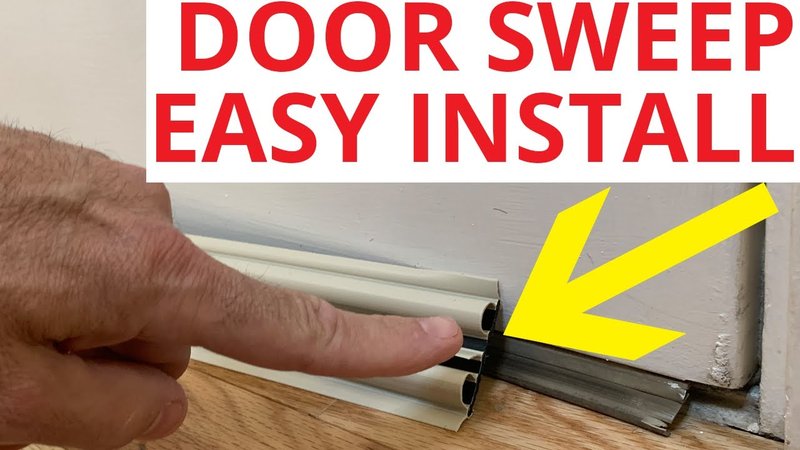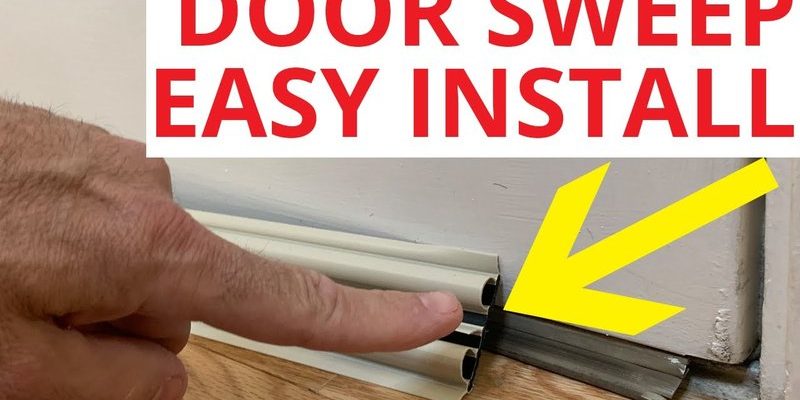
Full honesty? A poorly adjusted door sweep (whether it’s from Frost King, M-D Building Products, or a generic brand) can mess up your whole entry experience. Maybe your new sweep looked perfect in the package—tight against the floor, promising to block every breeze. But now you’re left wrestling the door, and wondering if you installed it wrong or if it’s just not the right fit. Let’s break down why door sweeps drag, what you can do about it, and how to fix that annoying resistance for good.
What Causes a Door Sweep to Drag on the Threshold?
Let me explain what’s really happening when your door sweep starts dragging. A door sweep is a strip (usually rubber, vinyl, or bristle) that attaches to the bottom of your door, sealing the gap between door and floor. It should lightly touch the threshold, not grind against it. But there are a few ways things can go wrong.
- Incorrect installation: Sometimes the sweep gets mounted too low. If it’s set well below the bottom edge, it’ll press into the threshold every time you move the door.
- Sagging doors: Doors aren’t static—over time, hinges get loose, or the whole door can sag. That brings the sweep closer to the threshold than it used to be, causing drag and resistance.
- Warped thresholds: Not all floors are perfectly flat. High spots in your threshold can snag the sweep, especially if the floor has warped or settled since installation.
- Worn or swollen sweeps: Age and weather can swell or curve the sweep down, making it longer than when it was new.
You might be wondering: does it really matter? Yes, because too much drag will chew up your sweep, scratch your floors, and make opening the door a pain, literally.
How to Identify the Source of the Drag
Before you reach for the toolbox, it helps to figure out where, exactly, the sweep is dragging. Here’s the thing: most folks assume the whole sweep is too low, but sometimes it’s just one section that’s making trouble.
Open and close the door slowly. Feel for resistance. Does the sweep get stuck halfway? Is the scrape only at one spot? You can even check for scuff marks, torn rubber, or spots where the sweep looks worn.
*Pro tip: Lightly dust the threshold with chalk powder. Open and close the door a few times. The areas where chalk rubs off first are your drag points.*
If you spot uneven contact, check if your threshold is warped or if the door has dropped on its hinges. It’s not always the sweep’s fault; sometimes, it’s the door or the floor changing shape over time.
Simple Fixes: Adjusting the Door Sweep Height
Here’s where a little effort pays off. If your sweep is mounted with screws (most popular types, like Frost King or M-D Building Products, use this style), you’re in luck. You can usually loosen the screws, nudge the sweep up a little, and retighten.
- Grab a screwdriver and loosen each mounting screw—just enough so the sweep can slide up and down.
- Lift the door slightly or wedge it to its ideal position, then raise the sweep until it barely touches the threshold.
- Tighten the screws while holding the sweep in place.
Tip: Aim for a slight, even contact with the threshold—enough to block air, but not enough to scrape. If you’re dealing with a bristle sweep (the kind with little flexible hairs), don’t compress the bristles flat; just let them kiss the floor.
Sometimes, you might need to trim the sweep itself. Most are designed to be cut carefully with a utility knife or heavy scissors. Just remember: go slow and trim a little at a time. You can always take off more, but you can’t add it back!
Advanced Troubleshooting: When Adjustments Aren’t Enough
Sometimes, the sweep adjustment only gets you halfway. If your door is sagged, or the threshold is warped, you’ll end up chasing your tail. Here’s what to check next.
Check for loose hinges. Open your door halfway and lift up on the handle. If you feel movement, the hinge screws may be loose. Tighten them up—sometimes that’s all it takes to lift the door and stop the drag.
If your threshold is warped or bulging, you might need to sand down any high spots, or even replace the threshold strip. For doors that swell in humidity (like old wood), sometimes you’ll need a little planing at the bottom edge. Just make sure you sand or plane sparingly, so you don’t create a gap under the sweep.
*Quick reality check: If weatherstripping, code, or building regulations require a certain seal, don’t over-trim or remove the sweep. Sometimes, you’ll have to replace the sweep with a different style that fits your specific door/threshold combo.*
Choosing the Right Door Sweep for Your Setup
Now, you might be thinking, “Is there a sweep that won’t drag at all?” There are a few different types, and picking the right one can save you a ton of frustration.
- U-shaped sweeps: These wrap around the bottom edge of the door and are easy to install—but if your threshold isn’t standard, they might drag.
- Adhesive sweeps: Peel-and-stick options are quick to install, but can peel or sag over time, especially with a lot of drag.
- Bristle sweeps: Flexible “hair-like” bristles work best for uneven floors, but still need correct height adjustment.
- Vinyl/rubber blade sweeps: Block drafts really well, but need to be cut and positioned accurately to avoid drag.
If your entryway is a high-traffic area, or if your floor is anything but flat, a bristle sweep is usually the most forgiving. But honestly, sometimes it’s a matter of trial and error to find what works best with your door and threshold.
Installing a New Door Sweep Without the Drag
Let’s walk through a fresh install—no more guesswork, no more scraping sounds.
- Remove the old sweep. Most unscrew easily, but adhesive types may need careful prying.
- Clean the bottom edge of the door and the threshold. Dust and debris will mess up both the seal and the fit.
- Mark the new sweep’s position. Hold it against the closed door and make sure it just touches the threshold—no squishing, no gap.
- Attach with screws (or adhesive as needed), double-checking alignment as you go.
- Open and close the door a few times, checking for drag. Make adjustments before tightening everything down permanently.
A well-installed sweep should feel almost invisible in daily use—no tugging, no scraping, just that quiet confidence of a draft-free doorway.
Keeping Your Door Sweep Working Smoothly Over Time
Honestly, most people forget about their door sweep until it starts causing problems. But a little routine check can save you a lot of hassle:
- Check the sweep every few months, especially after big weather swings. Vinyl and rubber can stiffen, shrink, or warp.
- Tighten screws if the sweep starts to sag or rattle.
- Clean dirt and grit off the threshold—grit can grind down both sweep and floor.
- If you notice resistance coming back, re-adjust or replace as needed. Swapping out a worn sweep is easier than dealing with a ruined floor or a gap under the door.
You might be surprised at how much difference a well-fitted sweep makes—no more chilly drafts, and no more fighting the door every time you head outside.
Comparing Universal Door Sweeps and Brand-Specific Options
You might be tempted to grab the cheapest universal sweep at the hardware store. Sometimes, that’s fine. But here’s what you should know:
- Brand-specific sweeps (like those from M-D Building Products or your door’s original manufacturer) are designed for a perfect fit, so you’re less likely to get annoying drag if you follow the instructions.
- Universal sweeps are made to fit “most doors,” which sometimes means they require more trimming or fiddling to get just right.
- Adhesive types don’t always hold up as well under heavy use, especially if there’s any drag. Screwed-in sweeps are sturdier but take a bit more effort to install.
If you’re troubleshooting a sweep that drags even after adjustment, switching brands or sweep types might give you better results. Don’t be afraid to try a couple of different styles—not all entryways are created equal.
Final Thoughts: A Smooth Door (and Life) Awaits
Dragging door sweeps are one of those little annoyances that can wear on you over time, but they’re totally fixable. Whether you’re adjusting, swapping brands, or replacing a worn-out strip, it’s all about finding that sweet spot where the sweep blocks drafts—but glides smoothly every time you open the door.
Remember, a well-fitted door sweep isn’t just about comfort. It’s about keeping your home sealed, your floors safe, and your daily routine just a bit smoother. Take your time, adjust carefully, and don’t be afraid to experiment. You’ll know you’ve got it right when you barely notice your sweep at all—except for the peace and quiet.
